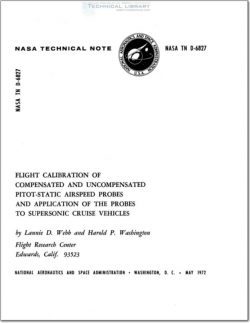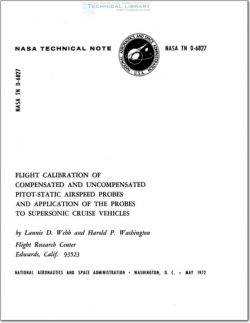NASA-TN-D-6827

- Version
- 209 Downloads
- 2.61 MB File Size
- 1 File Count
- June 16, 2016 Create Date
- June 16, 2016 Last Updated
Flight Calibration of Compensated and Uncompensated Pilot-Static Airspeed Probes and Application of the Probes to Supersonic Cruise Vehicles

Precise knowledge of Mach number and altitude is of utmost importance for super—
sonic cruise aircraft. The information is necessary for both pilot displays and auto—
matic systems. Even greater precision is required for evaluating the aircraft and the
propulsion system performance in flight. Seemingly minor errors in the measurement
of free—stream static pressure greatly affect the measurement of inlet recovery and
the range of the aircraft.
It has been common practice to calibrate nose—boom pitot—static systems in wind—
tunnel tests and in flight only through the transonic speed region and either to assume
that there was no supersonic error or to extrapolate the usually small supersonic error
to higher speeds. Experience with the XB—7O airplane (fig. 1) showed that neither
practice is adequate. In some instances wind—tunnel calibrations of pitot—static probes
at high supersonic speeds may also be inadequate unless the wind—tunnel tests provide
for very accurate measurements under simulated flight conditions.
The XB—70 airplane was flight—tested initially with a compensated pitot—static
probe which had a specially contoured shape near the static -pressure ports (ref. 1).
This probe was designed to reduce the measured position error experienced by un—
compensated pitot—static probes at transonic speeds and to maintain a minimal position
error at supersonic speeds. Early XB-7O flight tests produced inconsistent supersonic
calibration data. Because the reasons for the nonrepeatability of the data could not be
determined from the flight data, wind—tunnel tests were conducted at the NASA Langley
Re search Center by Virgil S. Ritchie and Frank L. Jordan, Jr. Subsequently, the
compensated pitot-static probe was replaced by a more conventional uncompensated
pitot—static probe (modified MA—I type). Although the uncompensated probe produced
a larger subsonic position error than the compensated probe, the supersonic data were
more consistent.
In this report flight and wind-tunnel data are combined to form a complete position—
error calibration. Position-error data from flight and wind—tunnel tests for both com—
pensated and uncompensated pitot—static probes are analyzed and compared with data
from other types of pitot—static probes. The effects of Reynolds number and angle of
attack on the data obtained from the pitot—static probes used on the XB—70 airplane are
discussed. The implications of using these types of probes on supersonic transports
or other aircraft operating at high speeds and altitudes are also discussed.
| File | Action |
|---|---|
| NASA-TN-D-6827 Flight Calibration of Compensated and Uncompensated Pilot-Static Airspeed Probes and Application of the Probes to Supersonic Cruise Vehicles.pdf | Download |

Comment On This Post